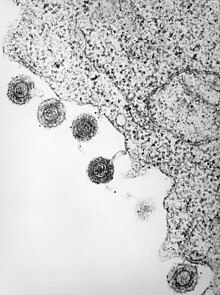Tegument (virus)

A tegument (Latin tegumentum for cover, skin) is in the virology a particular structure of the virus particle ( virion ) in some enveloped viruses. While there is normally only a cellular fluid between the inner capsid and the outer virus envelope (depending on where the virus particles ripen, the cytoplasm or the compartment fluid of the endoplasmic reticulum or the Golgi apparatus ), this space is filled with viral proteins in some viruses . In contrast to matrix proteins , which are structurally connected to the inside of the virus envelope, the tegument surrounds the capsid and is also attached to the capsid when the virus particles are assembled. One can distinguish an inner, very tightly packed tegument on the capsid surface, and an outer, rather loosely packed tegument towards the virus envelope. In the case of beta herpes viruses , an icosahedral network formed by two particularly large tegument proteins has been described on the inner tegument. The other, smaller tegument proteins are stored in this. The tegument is responsible for the typical "fried egg shape" of the herpes viruses in classic TEM images, as they widen the distance between the capsid and the shell and store contrast media to varying degrees during preparation. This makes the capsid particularly prominent within the virion on TEM images.
function
Teguments are best characterized in the Herpesviridae . A more precise representation of the protein composition was first achieved in 1976 with the Epstein-Barr virus . The often several dozen different proteins that make up the tegument have no morphological function; rather, they are responsible for a multitude of different control processes in the early phase of virus replication immediately after removal of the envelope ( uncoating ) and entry of the capsid into the cytoplasm. Since the tegument proteins are available immediately after the virus has entered and not only after they have been synthesized in the course of viral replication, they can, for example, immediately suppress the recognition of PAMPs in the cytoplasm and thus suppress the cellular defense against a virus infection. Some tegument proteins serve to switch off cellular synthesis pathways and thus to prepare for takeover by virus replication ( viral host shut-off , vhs proteins). By binding to cellular transcription factors, they specifically intervene in cellular gene expression and transcription . Tegument proteins can also contribute to the control of viral gene expression or the transition to a latency stage as viral cccDNA within the cell nucleus , as well as in the assembly of the capsids, the transport to the cell nucleus ( nuclear transport ) and to the Golgi apparatus, the modification of the cytoskeleton and the budding and Maturation of virions.
Origin of the tegument
The capsids of herpes viruses receive a primary virus envelope after budding on the nuclear membrane . These immature particles are then in the perinuclear cistern and do not yet have a tegument. After fusing again with the outer nuclear membrane and entering the cytoplasm, the particle loses this shell, whereupon, after the synthesis of the tegument proteins, these are attached to the bare capsid. By renewed budding on the membrane of the Golgi apparatus, the tegument-encased capsid receives its final viral envelope.
Individual evidence
- ↑ X. Yu et al .: Biochemical and structural characterization of the capsid-bound tegument proteins of human cytomegalovirus . J. Struct. Biol. (2011) 174 (3): pp. 451-460 PMID 21459145
- ↑ M. Dolyniuk et al .: Proteins of Epstein-Barr Virus. II. Electrophoretic analysis of the polypeptides of the nucleocapsid and the glucosamine- and polysaccharide-containing components of enveloped virus. J. Virol. (1976) 18 (1): pp. 289-297 PMID 176465
- ↑ BJ Kelly et al .: Functional roles of the tegument proteins of herpes simplex virus type 1. Virus Res. (2009) 145 (2): pp. 173-186. PMID 19615419
- ↑ H. Guo et al .: Role of tegument proteins in herpesvirus assembly and egress. Protein Cell. (2010) 1 (11): pp. 987-998 PMID 21153516